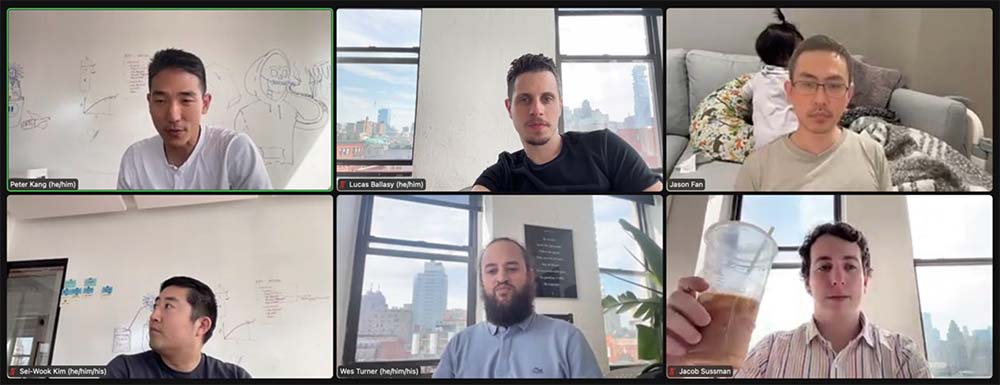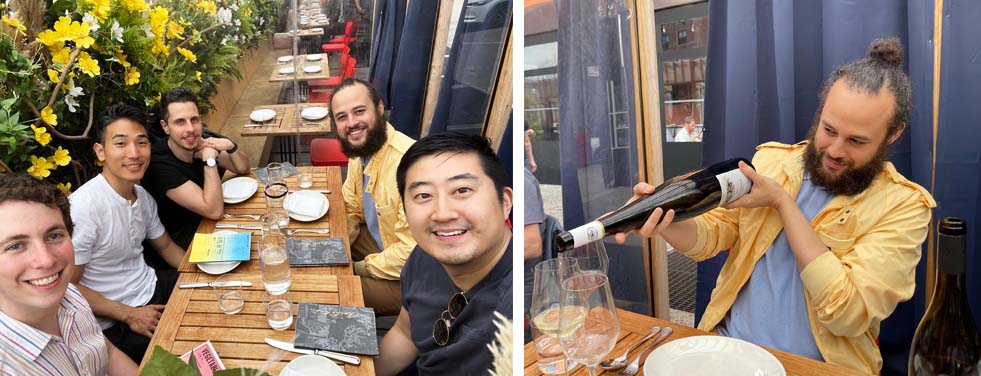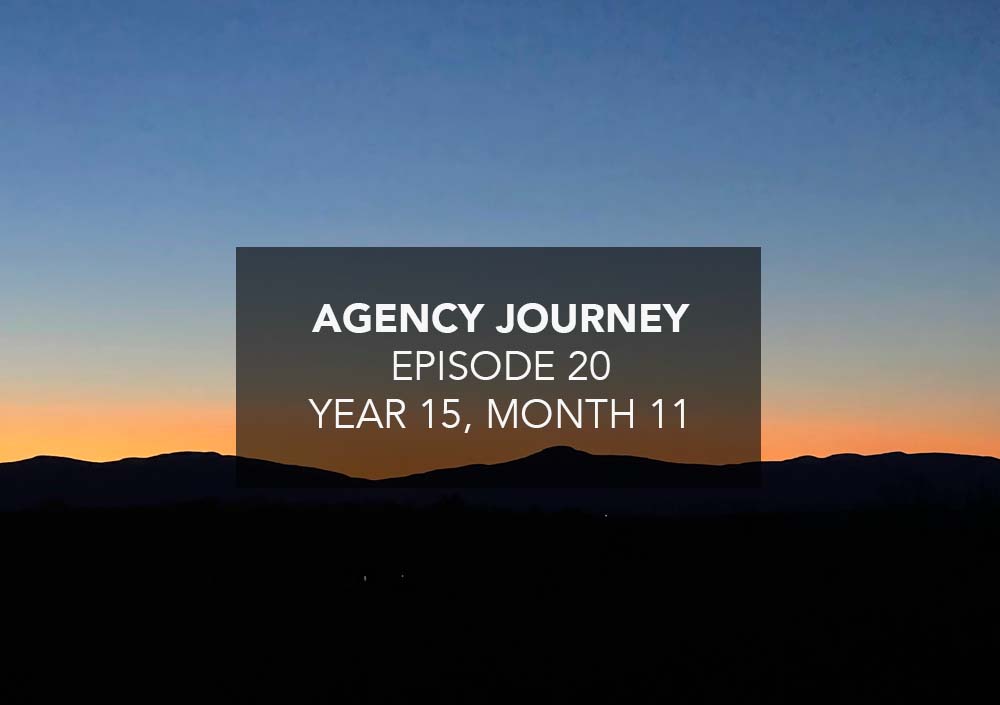Towards the end of last year, we had a client engagement that did not go well. Without getting into details, here’s what happened: the matter got so serious that we needed to get professional liability (errors & omissions) insurance involved. The insurance company assigned us a lawyer and there was a date set for mediation, where, hopefully, we could settle on an amount and move on.
This case hung over us like a dark cloud for months as we awaited mediation. As we got closer to the date, more details emerged and the communications and allegations became more intense and worrisome. We had no idea what to expect and whether or not a settlement would be easily achieved.
My co-founder Sei-Wook led this entire process and prepared diligently as best he could. In being point on this, he also bore most of the stress and weight of the situation. He represented us at mediation this past week, having lost a lot of sleep and fretting about worst-case scenarios.
Thankfully, the mediation led to a settlement for an amount we were mentally prepared for, and we’re incredibly grateful to have closed the chapter on this very stressful experience. The upside is that we learned a great deal from our mistakes and also got firsthand experience in how professional liability cases get handled. We hope to never have this type of situation again, but it’s also incredibly valuable to demystify something that was previously a black box to us.
The relief from being done with all this was, dare I say, as joyful as any big win or celebration. It absolutely energized us and filled us with gratitude for the opportunity to keep doing what we’ve been doing. We promised ourselves that we’ll keep getting better and to appreciate the feeling of lightness in having overcome all of this. The journey continues.
About Agency Journey: This is a monthly series detailing the happenings of my agency Barrel, founded in 2006. You can find previous episodes here.
Highlights
Barrel Holdings Quarterly Review

Our first ever Barrel Holdings Quarterly Review was handled in a hybrid fashion as Jason Fan (top right) conferenced in from Taiwan while the Barrel Partners and Jacob of BX Studio (bottom right) met at the Barrel office in Manhattan.
For the first time, we carved out a session during our all-day quarterly Barrel partner planning meeting to do a quarterly review with the other Barrel Holdings agencies. Jason Fan of Vaulted Oak and Jacob Sussman of BX Studio both joined to present how things were going on their ends. From our side, Sei-Wook presented Barrel’s business performance and outlook.
I was thoroughly impressed especially by Jason and Jacob’s presentations. In just a short period of time, they’ve been able to build up growing businesses with some really great clients and talent. Both companies are growing at a quick clip, developing their own unique processes and cultures, and providing value to clients. As with any growing business, the challenge will be to find and invest in talent, preserve our margins, and keep the flow of new business coming.

For some of the Barrel partners, this was their first time hanging with Jacob in-person. We all went out to dinner. Wes got to try his hand at pouring a magnum bottle of Riesling.
Personally, I was inspired by this meeting. Just a year ago, we had begun to float the idea of doing a holding company with multiple agency businesses. To see our vision come to life and to see these new ventures thrive was very heartening. It gave me some perspective, especially in light of all the challenges we’ve faced on the Barrel side of the business over the past 6+ months. Barrel itself is turning around and getting back on track, so I’m very much looking forward to our next Barrel Holdings Quarterly Review.
Longtime Client Gives Notice
A longtime client, one we had worked with for over 4 years, gave us notice and will be moving on to a different agency partner. It was bittersweet news but not totally unsurprising. The account had its fair share of ups and downs over the years. We’re proud of the work we’ve done with the brand. At the same time, we missed out on some opportunities to provide a better client experience, especially as we experienced attrition and had to continually replace team members working on the account. It was only towards the end that we had one of the Barrel partners become an Executive Sponsor with tighter oversight on the relationship. Lessons learned.
One reason that was given for ending the relationship was that our backing away from CRM/email marketing work (reminder: we laid off our entire CRM team back in February) was problematic for them as they needed more help in this area going forward. This is something I can live with, especially as we had tried repeatedly in the past to engage them on CRM work when we had a full team but to no avail.
Financially, we’ll be able to quickly replace and exceed the lost retainer amount with a new one. This client was grandfathered into an older retainer and had resisted upgrading to a larger engagement, which meant that we constantly ran out of hours every month and had to ask for approval on additional hours. Unfortunately for us, there were months where we did not do a good job of tracking and asking for additional hours but still did the work, meaning we gave away free hours while tying up the team from being able to work on other clients. Shame on us for that, something we’ve become laser-focused in preventing as a result.
Shifting C-Suite Responsibilities
We evolved the C-suite recently to reflect our changing needs. The biggest move was to shift the reporting structure so that our new Director of Software Engineer would now report to Lucas, our Chief Experience Officer (CXO). This comes after we’ve folded in the Project Management team under Client Services and transformed our Solutions Architecture team into the Strategy team. Both Client Services and Strategy teams are under Lucas as well.
This means that our Chief Technology Officer Wes Turner no longer oversees disciplines (what we call our departments). He is now responsible for thinking more broadly about technology across all disciplines and the company overall. We worked to flesh out his portfolio of responsibilities and how, much like Sei-Wook with finance, Wes can ensure that technology considerations are happening across accounts, projects, and teams. Some of the areas under Wes’s purview, especially in defining our approach to them, are: website analytics tracking, site performance, SEO, IT, web development workflows, quality assurance testing, data privacy, accessibility, and ecommerce platforms. A lot of these areas touch several disciplines, so being untethered from managing specific disciplines frees Wes to cross-pollinate and involve people from all across the company.
For Lucas, these changes mean that all disciplines that work directly on client engagements now report to him. He will directly oversee four Director-level discipline leads and be responsible for their performance and development as managers. We felt that this was a natural evolution as Lucas had already taken the initiative to run the Barrel Management Forum for all discipline leads and that bringing the teams under his leadership would allow for improved cross-discipline coordination and collaboration. To reflect the changes structurally, we’ve retired the “Creative Marketing Services” that Lucas headed and now refer to Design, Client Services, Strategy, and Software Engineering teams as being under the Experience team.
It’s been less than a year since we rolled out our C-level roles and responsibilities. We’ve had a great deal of learnings since then, and I think these latest changes will have meaningful impact on how we operate as an organization.
Top of Mind
Performance and Standards
In Q1 of 2022, we had quite a bit of turnover on the team. In addition to the 6 layoffs in February, we had 9 more people who left the company. We also added 7 new people, which gave us a net change of 8 less people on payroll. The volume was definitely more than the usual levels, but not unprecedented–we’ve experienced waves similar to these every now and then.
When we lose people through voluntary resignations, we always ask ourselves what we could have done to keep them longer. We also carefully read exit interviews to gain insights into why they left. Sometimes we get some good feedback that help drive changes in things like communication and staffing. Other times, it’s hard to tell what we could have done differently.
When we lose people through firings or mutually-agreed resignations, the thought that comes to mind without fail is: why didn’t this happen sooner? And this is where the topic of performance and standards burns hot for me–I think we as an organization will tolerate mediocrity for as long as possible because we hate to face the pain and inconvenience of replacing someone, even if it means the opportunity to find someone who is a much better fit.
I have nobody to blame but myself for this–for letting the culture develop in this way and not being clear about certain standards of performance. I’ve often conflated tolerance of mediocrity (or underperformance) with the belief that support, training, and patience can lead to improvement in the long run. It’s a fine line that quickly gets muddied because it’s easier to chalk up underperformance to someone needing a bit more guidance and oversight. It’s also very easy to get anchored to someone’s continued poor performance and then to feel hope or progress when there is slight improvement. The sense of “a really great performer in this role would be able to do X, Y, Z really well with reliable consistency” quickly gets forgotten, replaced by “yeah, there are still some issues but at least this person is getting better.”
The way around this is to have clear accountability measures and expectations in place, agreed to by the employee, with consistent check-ins and evaluation. We’ve had challenges getting clear on exactly what people should be accountable for and what we expect of everyone, hence, the moving target and inability to clearly point out performance deficiencies.
My intention is for us to develop clearer accountability measures throughout the organization so that all disciplines have their sets of performance standards that ladder up to company-wide performance standards. We’ve been slowly rolling out performance targets across all projects (profit margins) and will soon be sharing utilization targets with the entire team, helping people make the connection between their actions and the metrics that drive business performance.
The other part is less quantitive and more around behaviors and upholding what matters to our culture. I’ve begun meeting one-on-one with every team member to engage in a “re-onboarding” to align on our vision, mission, purpose, and maxims (our principles/core values). One part of the re-onboarding centers around expectations we have for each team member. These include: the importance of maximum participation in team and project meetings; being an excellent communicator especially with emails and messages; personal accountability especially with your own calendar; and being proactive in navigating uncertain situations vs. passively waiting for more context.
I know a single meeting with the CEO isn’t nearly enough to change people’s behaviors. In fact, the re-onboarding is more to align on language and to reiterate what everyone already knows. What’s more useful is that once everyone is clear on these expectations, we can, as an organization, more consistently reinforce these behaviors and draw attention when these expectations aren’t being met. Someone who hardly participates, is unresponsive or sloppy in their communication, and unwilling or unable to manage their own time can be given clear feedback on where they are falling short. If there is no improvement, we can take steps to have deeper conversations around their long-term prospects with the team. In other words, once we set the standards, we can make a more forceful and stronger case for who stays and who goes.
The ultimate litmus test for performance can be boiled down to this question: “Will I hire this person again?”
If, as a manger, the answer is not a definitive “Hell yes!!”, then, in my experience, you are most likely tolerating mediocrity or underperformance. You may have seen incremental improvement in someone over time that can be seen as promising, but more often than not, the fear is around having uncomfortable conversations and then having to deal with the inconvenience of replacing that person. I’ve caught (and also failed to catch) myself continually rationalizing and talking myself into keeping people, afraid to take the step that deep down I knew was the right thing to do.
Last bit on this–I think when we restructure and move people to a new manager role, we should provide that manager with the option to “re-interview” the team they’re inheriting and, for anyone on the fence, to put these people immediately on a performance improvement plan (PIP) to establish clear development areas. A manager can be hamstrung by having to oversee the performance of people he or she has not had a hand in hiring. Giving them the option to have a clean slate will most likely improve their odds of success. We’ve missed out on doing this too many times. I’ve also come to believe that PIPs should be used more frequently and normalized as a development tool rather than a cover your ass (CYA) human resources tool. The goal of a PIP should be to achieve improvement and to level someone up rather than trying to force them out.
Shared with Partners
“Last, but definitely not least, underdelegation causes senior people to neglect high-value tasks that are of critical importance to the future success of the firm. In firm after firm, I encounter senior professionals who know the importance of client service, business development, supervision and coaching, methodology-building, and personal development. In all of these cases, however, they report that they are not doing as much as they would like because they are “too busy”—and they are. But too busy doing what? If, with 50 percent of their time, they are too busy doing things that, with appropriate training, someone at a half or two-thirds their salary could do, it would seem that some bad trade-offs are being made in the allocation of these valuable people’s time.” (David H. Maister, Managing the Professional Service Firm)
It’s always worth revisiting the problem of underdelegation up and down the firm, first starting with myself and then observing others in senior roles and how they spend their time. One thing I’ve come across more than a few times is that underdelegation happens because of poor planning and lack of anticipation. Because the senior team member didn’t invest enough time upfront to map out and plan certain things, they are left to scramble and do the work that otherwise could have been delegated to a junior or offshore resource. The sad thing is that sometimes we give these people praise for the “extra effort” in late nights and weekend work, validating their hero ball actions. Best to keep an eye out and take steps to prevent as much as possible.
“Like with all our values, we tried to be upfront with people and manage personal performance aggressively. Be a driver, which we need, not simply a passenger on the ship, which we cannot afford on this leg of the journey. Passengers are ballast, cargo, deadweight freight—they are a resource sink, yet they end up in the same destination as the drivers. That is not right. If you’re not sure what you are, find out: do not be passive. Somebody once asked me how he or she would know whether they were a driver, and I answered, “you better find out before we do.” In other words, be more demanding of yourself. Are you increasing the company’s speed or not?” (Frank Slootman, Tape Sucks)
I love this quote and it resonated so deeply with me. I understand why the culture I ultimately want for Barrel is one that’s not for everyone. Some people demand that they be pampered and entitled passengers on ships. This is unacceptable for me, and as long as I run Barrel, I will fight to work alongside drivers.
“The future is solely created in the present. The future can’t be created in any other place but the present. What an individual creates “now” determines what the new “now” or what we call the future will look like.” (Dusan Djukich, Straight-Line Leadership)
This book talks about having an “inner stance” that helps leaders get from A to B by doing whatever is necessary. The belief that what we do in the present shapes the future is a powerful one–the individual has the agency to make choices that can create a new future. Instead of complaining, procrastinating, or wishing for something, there is always the choice to do something about it. I also like to think of this quote whenever I find myself mindlessly browsing social, checking email, or watching videos–what kind of future am I creating when I spend too much time like that?
